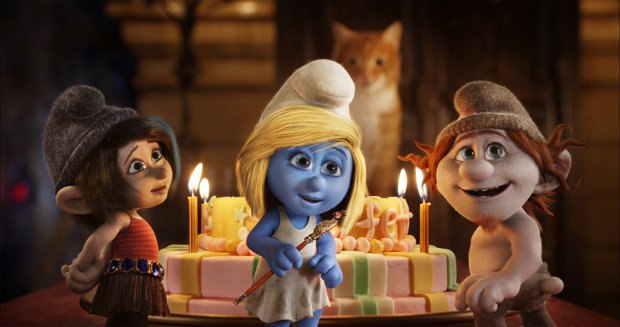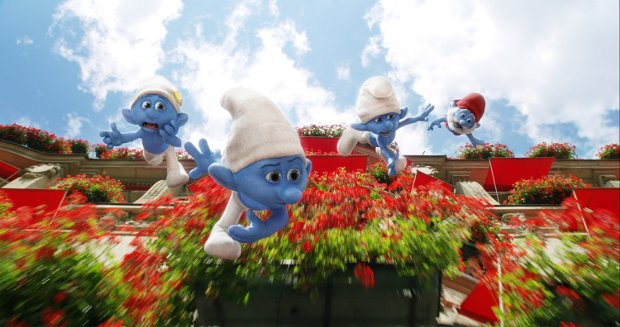The director walks us through his latest animated/live-action feature.
Whether you have kids of your own or happen to be a big kid at heart, you’ve surely noticed there’s a new Smurfs movie currently in theatres. Those big blues faces and white hats are hard to miss. The picture marks director Raja Gosnell’s second opportunity to play with Peyo’s iconic characters, who this time around find themselves on a rescue mission in the City of Lights. After directing a string of other successful CGI/live action hybrid films, like Scooby-Doo and Beverly Hills Chihuahua, one might assume Gosnell would view this latest project as a walk in the park. Apparently, it was quite the opposite, as he reveals in our exclusive interview. To learn just which sequences plagued and pleased him – and how to best determine someone’s level of Smurfiness – read on.
James Gartler: You’ve done a lot of work editing live action films – how did you transition into working on these animated/live-action movies?
Raja Gosnell: I tend to be drawn to scripts that are hard to do. Like when I read a script, something in my head says, “Well, how the hell would you do that?” Those are the scripts that I’m interested in. I think it’s about personality. I’m not necessarily an animation director or a big special effects movie guy, but the challenges of making these movies are part of what keeps it interesting for me.
JG: Back when the first Smurfs movie was being discussed, was there ever a time when the studio thought of making it a 2D hand-drawn feature?
RG: I think this is a better question for Jordan Kerner, who developed it initially, but I believe the initial decision was that it would be animated, but I don’t know whether it was hard-drawn or 3D. This was about 10 years ago. When the Chipmunks movie did so well, I think the decision was made to make it a hybrid.
JG: In this sequel, the Smurfs once again find themselves in the real world dealing with real people. Can you speak about the decision to go in that direction, versus setting the picture entirely in the Smurf village?
RG: Well, the overall goal was to make a film that would be pleasing to the longtime fans but also introduce it to a whole new generation. The people who enjoyed the Hanna-Barbera cartoons from 1981 through 1990 are probably in the childbearing years now, and so we thought that we would have the adults and the kids both interested by setting it in the real world. There are fifty years of Peyo books and almost ten years of cartoons, so if people want those stories, there’s a treasure trove of those out there. We wanted to do something a little bit different than what had been done in the past and we worked very closely with Veronique Culliford and her brother Thierry, who have continued to protect the Smurfs property.
JG: From a technical standpoint, do you feel like the lessons you learned while making the first movie made tackling this sequel easier?
RG: I wouldn’t say “easier”, I would say “better.” It’s never easy. It’s an intensely technical process that takes a lot of calculation and a lot of preparation. Is the camera the right distance off the ground? We’re going to be shooting Smurfette, so how do we get the camera to move through the real world in the way it should, following these characters? Motion picture equipment isn’t built to be seven inches off the ground and race through buildings and do all sorts of things that we want our Smurfs to do.
You also have to think about the lightning controls and the technology behind them. Digital fx supervisor Theo Bialek was our main lighting guy and he did a fantastic job of making the Smurfs look real. I mean we’re talking Smurfs on the street in Paris – the amount of importance you have to place on making them look real in those situations is huge because if it totally doesn’t look convincing, the whole reality of the piece falls apart. That’s something that, if it’s a Pixar or a DreamWorks movie, you don’t have to worry about because they’re creating their own world, so the characters just naturally fit into it. We have to go the extra mile, so we’re talking about the skin textures, we’re talking translucence of skin, we’re talking about the blood that runs through them. The end result is that I look at these characters and believe that they’re alive and that they have little souls and little hearts and that if something bad happens they’ll get hurt.
I’d say that Sasha Kapijimpanga, the animation supervisor, did such a great job creating these really nuanced performances. Obviously, we have our big jokes and the sorts of things you see in the trailer, but what’s not in the trailer and what people won’t expect is that there’s a very nuanced relationship between Smurfette and Vexy that takes place during the course of the movie. They start as kidnapper and kidnappee and sort-of realize they’re sisters and end up fighting for each other’s lives by the end of the movie. There’s kind of a sisterly love story between those two characters and I think that will surprise a lot of people.
JG: Vexy, of course, is played by the wonderful Christina Ricci. How did you go about casting her in the part?
We have a whole technique whereby we choose our voices. We do a “blind taste test” so to speak, where we tape pictures of characters to the wall and then we listen to a variety of recordings that the casting people have prepared, like clips of interviews. It’s not anything really identifiable, so we won’t recognize them and say “oh let’s use so-and-so.” It’s interesting that some people just sound Smurfy and some people don’t. When we heard Christina she just sounded very Smurfy and she had a very cool, street-smart Vexy version of it, so I was really, really happy to get her.
JG: The film also features Jonathan Winters again, in what sadly turned out to be his final performance. He was part of the cast of the original cartoon series…
RG: Yes, I believe he did Grandpa Smurf during the Hanna-Barbera years. Of course for us, he was the moral and emotional centre of the movies as Papa Smurf. If there’s another film, we would definitely have to recast Papa. We wouldn’t try to get someone to imitate Jonathan. I think that would be sort-of disrespectful, so we’ll do the James Bond thing to find the perfect Papa that we can for now.
JG: Which were the most challenging sequences for you in the picture?
RG: Technically, the sequence in Notre Dame was probably the trickiest to pull off because we couldn’t afford to build it in CG and we were worried about how that would look anyway. So, through a very complicated process, they built a greyscale version of the cathedral and then took literally hundreds of thousands of still frame photographs and somehow mapped them onto the grey architecture. That’s what created a couple of those shots. We also did some old-school Star Wars Ewoks chase things with a steady cam and sped it up as we went through the actual buttresses. We didn’t struggle, but figuring out the right process took a lot of time.
Another sequence that took a lot of figuring out was Hank Azaria’s Gargamel doing his stage show. In the movie it takes place in the famous Palais Garnier, but we couldn’t shut them down for two weeks while we filmed. So we filmed all of Hank’s onstage elements in Montreal at Theatre Denise Pelletier and then we had to go back and try to duplicate all those camera angles in the Palais, and we had to do it in one night. So we were all seriously crossing our fingers going “this should work…on paper it works…I hope this works!” We were running around setting up cameras in the middle of the night and we had to be out of there in the morning because it’s a national monument and they have tours and stuff. So that was a challenging one.
The scene I’m most proud of probably is a sequence where Vexy and Hackus – the new creatures Gargamel has created and wants to turn into true blue Smurfs – they’re basically dying and they need Smurf essence to continue to live. Smurfette knows if she gives Gargamel the formula, it’s going to be bad for the Smurfs who are sort-of her adopted family and so she has this decision to make: whether to betray all the Smurfs to save Vexy and Hackus’ lives, or not. It’s this incredibly emotional, beautifully animated scene and Katy Perry’s performance is amazing and Hank’s performance is amazing and if someone only watches one scene in the movie, I’d recommend watching that.
JG: Did you enjoy your experience filming in Montreal?
It was unbelievable - probably one of the best film experiences I’ve ever had. All of the teams were so smart and so helpful and just jumped in. It really felt like it was a team atmosphere. There was never a "that’s not my department" sort of attitude, it was more like ‘yeah, yeah, yeah – let’s all jump in and get it done!’It was just a fantastic experience, and if we’re lucky enough to make a Smurfs 3, we’ll be back!
--
James Gartler is a Canadian writer with a serious passion for animation in all its forms. His work has appeared in the pages of Sci Fi Magazine, and at the websites EW.com and Newsarama.com.












